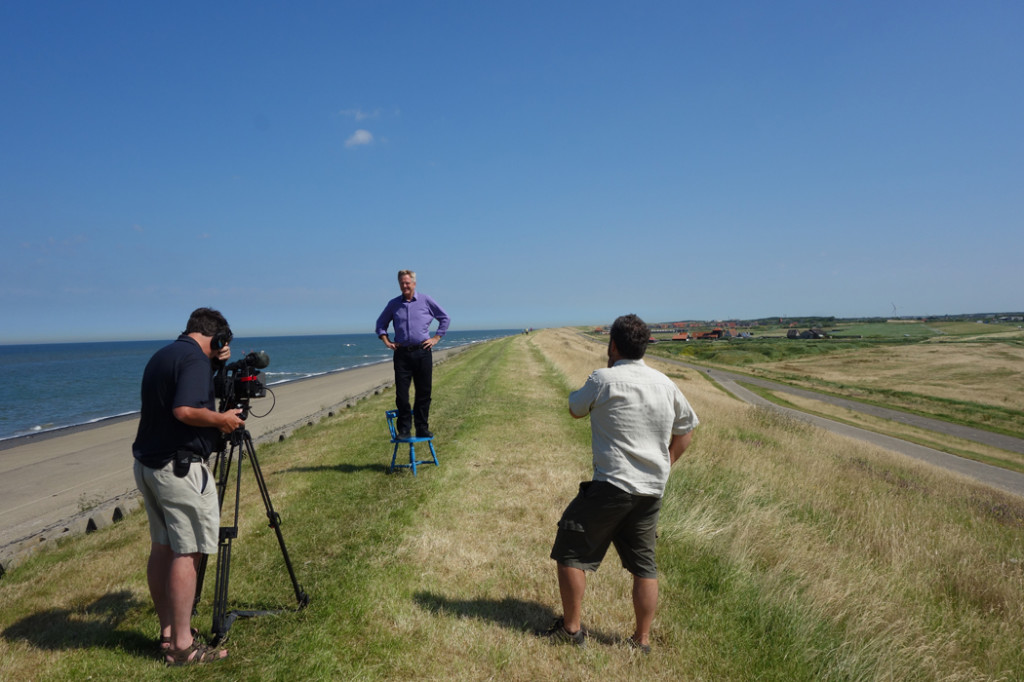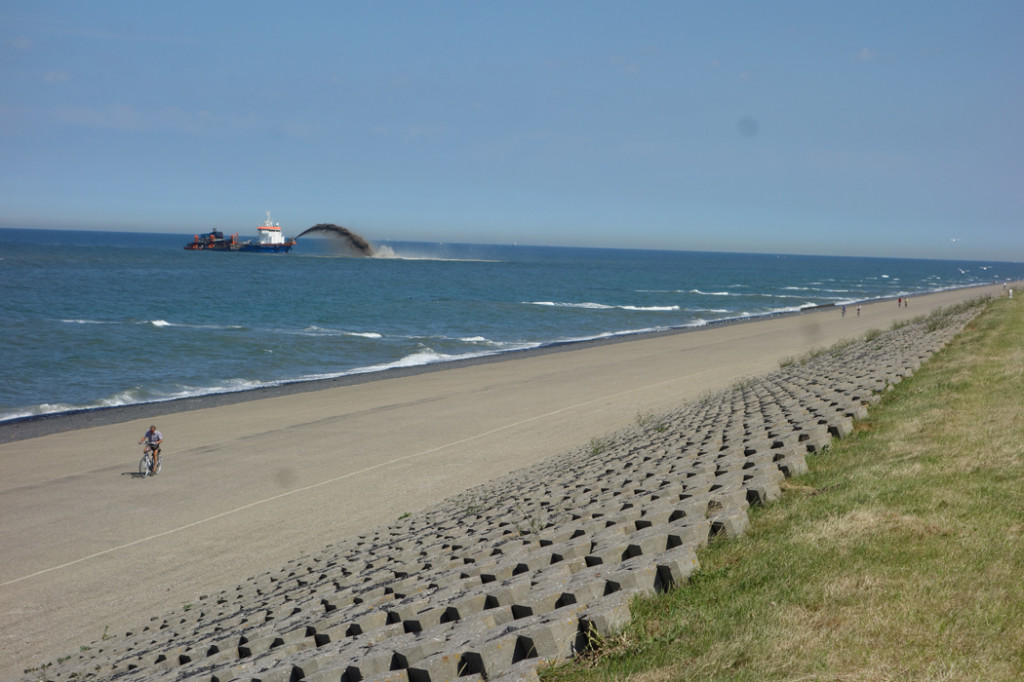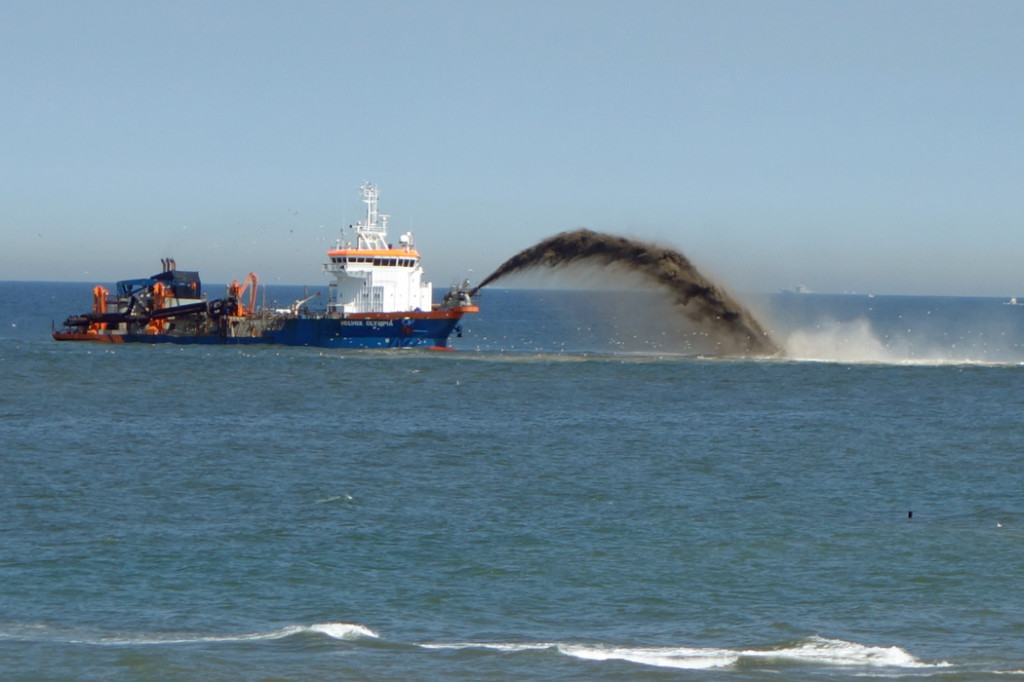With the affluence of our time, all over Europe, once-scuzzy neighborhoods on “the wrong side of the tracks” are becoming gentrified. (In fact, here in Copenhagen, the trendiest new area for dining and nightlife fun is the old Meatpacking District, just a couple of blocks behind the main train station.) Stepping into the station, I’ve long heard the martial melodies they play on loudspeakers at its back door without giving it a second thought. Then, with the help of a guide, I learned the reason for the regimented march beat. This video clip explains:
Having Fun in Copenhagen
Flying from Amsterdam to Copenhagen is like connecting sister cities — bikes, canals, lots of construction work, slick and extensive infrastructure, and people who really know how to have fun.
As I mentioned earlier, my two-month summer trip has five sections: Germany guidebook research, filming in the Netherlands, Scandinavia guidebook research, filming in Berlin and Prague, and finally guidebook research in Poland. I’m just kicking off part three and ready for some Scandinavian travel fun. Join me for the next two weeks as I offer my latest travel tips from in and around Copenhagen, Stockholm, Oslo, and Bergen. First up: Copenhagen.
In cities like Copenhagen, I enjoy tuning into the little details of everyday life. For example, the pølse (hot dog) is fast, cheap, tasty, and — like its American cousin — almost worthless nutritionally. Even so, what the locals call the “dead man’s finger” is the dog Danish kids love to bite. Danes gather at pølsevogne (sausage wagons) for munchies and pølsesnak — the local slang for empty chatter (literally, “sausage talk”). If you join them, you can study this institution — and maybe pick up on some societal insights, as well. Denmark’s “cold feet cafés” are a form of social care: People who have difficulty finding jobs are licensed to run these wiener-mobiles. As they gain seniority, they are promoted to work at more central locations. Traditionally, after getting drunk, guys stop here for a hot dog and chocolate milk on the way home — that’s why many of these stands stay open until the wee hours.
Wandering Copenhagen’s harborfront, visitors are struck by the many young people out drinking in the streets. There’s not more beer consumption here than in the US; it’s just out in public. Many young Danes can’t afford to drink in a bar (where the tax on serving booze is astronomical), so they “picnic drink” their beers in squares and along canals, spending a quarter of the bar price for a bottle from a nearby kiosk. In my guidebook’s self-guided walk of Copenhagen, I encourage my travelers to drop by Nagib’s kiosk (a block from the popular wharf at Nyhavn) and grab a cold $2 beer to join in the scene. It was fun meeting Nagib, as for years, he’s had a steady stream of Americans dropping by to buy a beer…as dictated by some mysterious guidebook writer.
Appreciating local culture extends to sightseeing, as well. When you’re traveling, don’t just seek out the Van Goghs in Sweden, the Rembrandts in Scotland, or the Titians in Spain. Instead, open up to the local artists. In Norway, check out Munch. In Vienna, go for Klimt. And in Prague, give Mucha a look. All over Copenhagen, you’ll see the swoon-worthy art of the great Danish Neoclassical sculptor Bertel Thorvaldsen. This local Canova’s work is in the cathedral, in the palace, and packing a museum dedicated entirely to his statues right next to the palace. Do you have a favorite underrated national artist that we should keep on our list when in that artist’s homeland?
Copenhagen is a city of lovely spires and public spaces. As in many towns, once-formidable fortified walls and moat systems have morphed into peaceful, lake-filled parks. In the maps of these cities, you can see the “star fort” shapes centuries after the last cannon was retired. Copenhagen does a particularly good job of utilizing land formerly spent on defense to make the city a wonderful place to live. Wandering through these parks, you can understand why Danes usually top the list of the world’s most content societies.





Escaping Amsterdam with an Idyllic Countryside Canal Canoe Trip
I’ve recommended Majel Tromp’s Wetlands Safari tours in my guidebook for over a decade. And I filmed a segment with Majel years ago, when 60 Minutes did a feature on my work. It was so beautiful, I wanted to get the experience into one of our travel shows. And on this trip, it worked out perfectly.
For a little break from the Amsterdam scene, we headed into the polderland just half an hour north of the city for a canoe ride. Gliding along the canals, where the homes face the water and everyone has their own little boat, was a delight.
When we finished filming the canoe ride, Majel surprised us with a grand picnic dinner on a remote island. After putting away the dishes, we turned her tablecloth tarp into a big bedspread and took a scenic nap. I truly savored the moment, knowing that we had two great shows — one on the Netherlands and one on the great city of Amsterdam — in the can. They’ll be seen all over the USA this fall.





Dutch Dikes: Keeping the Netherlands Dry for 700 Years
While dikes are a Dutch cliché (right up there with tulips and wooden shoes), they’re also an essential part of the Netherlands’ history and contemporary life. Roughly half of the land and half of the people here in the Netherlands are below sea level. And our new television show about the Netherlands includes a segment on these marvels of Dutch engineering.
The Netherlands is bounded by the North Sea. Where there are no natural dunes to keep the sea out, the Dutch have built mighty barriers, or dikes, to protect their farms and communities. For 700 years, the Dutch have been developing their skills at keeping this country dry. It’s a constant battle. And with climate change and rising sea levels now a reality, the work is that much harder and more expensive.
Each of our shows begins with a goofy little bit (called a “tease”) where I say a something about the destination, then reveal the location in a fun way. For our Netherlands show tease, I stood on a chair and said, “Hi, I’m Rick Steves, back with more of the best of Europe. The people here claim if you stand on a chair, you can see all across their country. We’re exploring the best of the Netherlands. Thanks for joining us.”
I was so happy with what we shot. Then, as we were driving away, I realized it would have been stronger if I added “this country is so small and so flat, they say if you stand on a chair…” But it was still a fun bit.
 When it came time to stand on the chair and say my line, Rolinka drove into the neighboring farm hamlet and had no trouble finding us the perfect chair for our needs. In fact, the friendly farmer brought two chairs so that we’d have a choice.
When it came time to stand on the chair and say my line, Rolinka drove into the neighboring farm hamlet and had no trouble finding us the perfect chair for our needs. In fact, the friendly farmer brought two chairs so that we’d have a choice.
 My line about standing on a chair to see all the way across the Netherlands is a joke. But from way up here, you really can see for miles.
My line about standing on a chair to see all the way across the Netherlands is a joke. But from way up here, you really can see for miles.
 Modern dikes work hard — as they have for centuries — to preserve drained and reclaimed Dutch land.
Modern dikes work hard — as they have for centuries — to preserve drained and reclaimed Dutch land.
 Even with an impressive dike already in place, the Dutch are moving mountains of sand and mud to fortify their dikes and protect the next generation. Famous for both their frugality and their foresight, the Dutch are investing billions of euros as climate change makes its costly impact felt on sea-level communities here and around the globe.
Even with an impressive dike already in place, the Dutch are moving mountains of sand and mud to fortify their dikes and protect the next generation. Famous for both their frugality and their foresight, the Dutch are investing billions of euros as climate change makes its costly impact felt on sea-level communities here and around the globe.
Sailing the IJsselmeer
We’re sailing to the fishing village of Marken in a hundred-year-old fishing boat. A few of these venerable boats survive. This one earns its keep by hiring out to visitors…and, in the case of this motley crew, putting them to work.